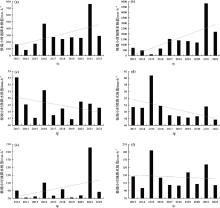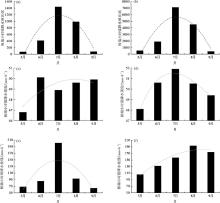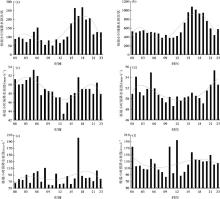国际刊号:ISSN 1673-503X
国内刊号:CN 21-1531/P

Journal of Meteorology and Environment ›› 2024, Vol. 40 ›› Issue (5): 20-29.doi: 10.3969/j.issn.1673-503X.2024.05.003
• Articles • Previous Articles Next Articles
Wei WU1( ),Zhongxia DUAN2,Qiongna XIE1
),Zhongxia DUAN2,Qiongna XIE1
Received:2023-03-03
Online:2024-10-28
Published:2024-12-17
CLC Number:
Wei WU,Zhongxia DUAN,Qiongna XIE. Comparative analysis of extreme hourly precipitation characteristics in Henan province based on the observations from national and regional stations during the warm season[J]. Journal of Meteorology and Environment, 2024, 40(5): 20-29.
Table 1
Number of stations and its proportion for hourly maximum precipitation with different intervals at national and regional stations from 2013 to 2022 in Henan province"
| 站型 | 降水量/mm | [30,40) | [40,50) | [50,60) | [60,70) | [70,80) | [80,90) | [90,100) | [100,150) | ≥150 |
| 国家站 | 站数/个 | 4 | 26 | 32 | 25 | 20 | 6 | 4 | 4 | 1 |
| 占比/(%) | 3% | 21% | 26% | 21% | 17% | 5% | 3% | 3% | 1% | |
| 区域站 | 站数/个 | 536 | 854 | 788 | 530 | 296 | 145 | 96 | 79 | 2 |
| 占比/(%) | 5.3% | 24.3% | 22.5% | 15.1% | 8.4% | 4.1% | 2.7% | 2.3% | 0.06% |
Table 2
Variation of extreme hourly precipitation thresholds at different percentiles from 2013 to 2022 in Henan province"
| 百分位 | 小时降水量/mm | 站点占比/(%) | |||||||||
| 最小值 | 最大值 | 中位数 | ≥20 mm·h-1 | ≥50 mm·h-1 | |||||||
| 国家站 | 区域站 | 国家站 | 区域站 | 国家站 | 区域站 | 国家站 | 区域站 | 国家站 | 区域站 | ||
| 95% | 8.4 | 6.4 | 20.6 | 33.7 | 15.6 | 15.8 | 4 | 14 | 0 | 0 | |
| 98% | 12.5 | 7.8 | 34.9 | 69.2 | 24.2 | 24.9 | 86 | 77 | 0 | 0.3 | |
| 99% | 18.2 | 8.4 | 46.8 | 104.8 | 31.6 | 32.6 | 97 | 95 | 0 | 5 | |
| 99.5% | 24.1 | 12.2 | 58.2 | 134.4 | 39.4 | 41.0 | 100 | 99 | 10 | 23 | |

Fig.6
Annual variation of extreme hourly precipitation frequency at national stations (a) and regional stations (b), extreme hourly precipitation intensity at national stations (c) and regional stations (d), and extreme hourly precipitation value at national stations (e) and regional stations (f) from 2013 to 2022 in Henan province"


Fig.7
Monthly variation of extreme hourly precipitation frequency at national stations (a) and regional stations (b), extreme hourly precipitation intensity at national stations (c) and regional stations (d), and extreme hourly precipitation value at national stations (e) and regional stations (f) from 2013 to 2022 in Henan province"


Fig.8
Diurnal variation of extreme hourly precipitation frequency at national stations (a) and regional stations (b), extreme hourly precipitation intensity at national stations (c) and regional stations (d), and extreme hourly precipitation value at national stations (e) and regional stations (f) from 2013 to 2022 in Henan province"

| 1 | 王萃萃, 翟盘茂. 中国大城市极端强降水事件变化的初步分析[J]. 气候与环境研究, 2009, 14 (5): 553- 560. |
| 2 |
常姝婷, 白雪, 曲梓祎, 等. 全球变暖趋缓背景下辽宁夏季降水变化及水汽输送特征[J]. 气象与环境学报, 2021, 37 (3): 57- 64.
doi: 10.3969/j.issn.1673-503X.2021.03.008 |
| 3 | 孙继松, 雷蕾, 于波, 等. 近10年北京地区极端暴雨事件的基本特征[J]. 气象学报, 2015, 73 (4): 609- 623. |
| 4 |
董良鹏, 张萍萍. 2020年湖北省两次低涡型极端降水气象因子异常特征对比[J]. 气象与环境学报, 2022, 38 (6): 20- 28.
doi: 10.3969/j.issn.1673-503X.2022.06.003 |
| 5 | 谌芸, 孙军, 徐珺, 等. 北京721特大暴雨极端性分析及思考(一)观测分析及思考[J]. 气象, 2012, 38 (10): 1255- 1266. |
| 6 | 田付友, 郑永光, 张小玲, 等. 2017年5月7日广州极端强降水对流系统结构、触发和维持机制[J]. 气象, 2018, 44 (4): 469- 484. |
| 7 | 江远安, 尹宜舟, 陈鹏翔, 等. 1961—2014年新疆降水极值概率特征及拟合不确定性分析[J]. 气候变化研究进展, 2017, 13 (1): 52- 60. |
| 8 | 王莉萍, 王维国, 张建忠. 我国主要流域降水过程时空分布特征分析[J]. 自然灾害学报, 2018, 27 (2): 161- 173. |
| 9 |
薛啟, 唐亚平, 王丽娜, 等. 2015—2019年甘肃平凉地区夏季短时强降水时空分布及天气形势特征[J]. 气象与环境学报, 2022, 38 (1): 57- 64.
doi: 10.3969/j.issn.1673-503X.2022.01.008 |
| 10 | 李建, 宇如聪, 孙溦. 中国大陆地区小时极端降水阈值的计算与分析[J]. 暴雨灾害, 2013, 32 (1): 11- 16. |
| 11 | 侯淑梅, 孙敬文, 孙鹏程, 等. 基于加密自动气象观测站和国家气象观测站的山东省极端短时强降水时空分布特征的对比分析[J]. 气象, 2020, 46 (2): 200- 211. |
| 12 | 吴梦雯, 罗亚丽. 中国极端小时降水2010—2019年研究进展[J]. 暴雨灾害, 2019, 38 (5): 502- 514. |
| 13 | 卢珊, 胡泽勇, 王百朋, 等. 近56年中国极端降水事件的时空变化格局[J]. 高原气象, 2020, 39 (4): 683- 693. |
| 14 | 韦志刚, 李娴茹, 刘雨佳, 等. 1961—2018年华南年和各季极端降水变化特征的比较分析[J]. 高原气象, 2021, 40 (6): 1513- 1530. |
| 15 | 赵海军, 曹洁, 潘玲, 等. 2007—2019年山东省短时强降水时空分布特征[J]. 海洋气象学报, 2021, 41 (2): 149- 155. |
| 16 | 张志富, 希爽. 1961—2017年中国中东部暖季小时强降水时空变化特征[J]. 气象与环境科学, 2022, 45 (5): 1- 7. |
| 17 | 廖胜石, 卓健, 罗建英, 等. 广西汛期极端短时强降水特征分析[J]. 暴雨灾害, 2022, 41 (3): 308- 314. |
| 18 | 宇如聪, 李建, 陈昊明, 等. 中国大陆降水日变化研究进展[J]. 气象学报, 2014, 72 (5): 948- 968. |
| 19 | 陶局, 唐燕玲, 易笑园, 等. 近10 a浙江省极端短时强降水时空特征分析[J]. 暴雨灾害, 2021, 40 (6): 599- 607. |
| 20 | 张天宇, 李永华, 程炳岩, 等. 三峡库区汛期极端降水非均匀性特征[J]. 长江流域资源与环境, 2011, 20 (3): 298- 304. |
| 21 | 雷蕾, 孙继松, 何娜, 等. "7.20"华北特大暴雨过程中低涡发展演变机制研究[J]. 气象学报, 2017, 75 (5): 685- 699. |
| 22 | 苏爱芳, 席乐, 吕晓娜, 等. 豫北"21 · 7"极端暴雨过程特征及成因分析[J]. 气象, 2022, 48 (5): 556- 570. |
| 23 | 余卫东, 柳俊高, 常军, 等. 1957—2005年河南省降水和温度极端事件变化[J]. 气候变化研究进展, 2008, 4 (2): 78- 83. |
| 24 | 朱业玉, 顾万龙, 王记芳, 等. 河南省汛期极端降水事件分析[J]. 长江流域资源与环境, 2009, 18 (5): 495- 500. |
| 25 | 栗晗, 王新敏, 张霞, 等. 河南"7 · 19"豫北罕见特大暴雨降水特征及极端性分析[J]. 气象, 2018, 44 (9): 1136- 1147. |
| 26 | 张霞, 王新敏, 栗晗, 等. 基于环境参数的极端暴雨指数构建及其应用[J]. 气象, 2020, 46 (7): 898- 912. |
| 27 | 苏爱芳, 吕晓娜, 崔丽曼, 等. 郑州"7.20"极端暴雨天气的基本观测分析[J]. 暴雨灾害, 2021, 40 (5): 445- 454. |
| 28 | 王婧羽, 李哲, 汪小康, 等. 河南省雨季短时强降水时空分布特征[J]. 暴雨灾害, 2019, 38 (2): 152- 160. |
| 29 | 杨军勇, 苏爱芳. 河南省暖季小时极端降水时空分布特征[J]. 暴雨灾害, 2021, 40 (2): 153- 159. |
| 30 | 中国气象局. 地面气象观测资料质量控制: QX/T 118—2010[S]. 北京: 气象出版社. |
| 31 | 苏爱芳, 孙景兰, 谷秀杰, 等. 河南省对流性暴雨云系特征与概念模型[J]. 应用气象学报, 2013, 24 (2): 219- 229. |
| 32 | 侯春梅, 陈忠民, 康雯瑛, 等. 河南汛期暴雨时空分布特征及成因分析[J]. 气象与环境科学, 2008, 31 (2): 39- 42. |
| 33 | 陈炯, 郑永光, 张小玲, 等. 中国暖季短时强降水分布和日变化特征及其与中尺度对流系统日变化关系分析[J]. 气象学报, 2013, 71 (3): 367- 382. |
| [1] | DAI Jiageng, ZHAO Hujia, XU Jia, WANG Yangfeng, WANG Peng, MA Wenbo, SU Xiaolei, XU Lei. Characteristics of pH value of precipitation in Liaoning province from 2021 to 2022 [J]. Journal of Meteorology and Environment, 2024, 40(5): 50-56. |
| [2] | Dongnan LI,Qiannan GAO,Guozhi SUN,Pengfei SUN,Ximing ZHANG,Qiang XIA. Spatiotemporal distribution of precipitation in Heilongjiang province from 1991 to 2021 [J]. Journal of Meteorology and Environment, 2024, 40(2): 17-25. |
| [3] | Xiaoxuan SU,Xiaowei SUN,Chenhe ZHANG,Jia-qi LI,Zengxin LU,Xu YANG. Application and verification of the spatiotemporal projection model in the extended-range forecast of summer precipitation in Northeast China [J]. Journal of Meteorology and Environment, 2024, 40(1): 27-36. |
| [4] | Yue RUAN,Jinqin FENG,Tingting LI,Qiuping CHEN. Analysis of three-dimensional lightning of hail and short-term heavy rainfall in Fujian province from 2017 to 2020 [J]. Journal of Meteorology and Environment, 2023, 39(4): 147-154. |
| [5] | Ming-wei ZHOU,Yue-yu LIU,Hao HUANG,Xin HU,Wei LIU. Relationship between terrain factors and ground lightning activity in Changsha area based on DEM data [J]. Journal of Meteorology and Environment, 2022, 38(6): 106-111. |
| [6] | Kai WANG,Xiao-yu JU,Yang-yang QIU,Xiang-yang CHENG. Distribution characteristics of lightning in southern mountain areas and northern plains of Anhui province [J]. Journal of Meteorology and Environment, 2022, 38(4): 110-117. |
| [7] | Rong-wei LIAO, Xiao-yi FANG, Huai-yu LIU, Yu-jing CAO, Dong-bin ZHANG, Yu-zhou ZHU. Quality control of seconds temperature and pressure data [J]. Journal of Meteorology and Environment, 2022, 38(4): 118-126. |
| [8] | Hui-meng BAO,Da-feng GUO,Wei LI. Correction tests of ECMWF modeling quantitative precipitation using frequency matching method in Jiangxi provice [J]. Journal of Meteorology and Environment, 2022, 38(2): 12-20. |
| [9] | Tulinisha,Da-wei AN,Chao ZHANG,Bi-xin YU,Chun-yan CHEN. Characteristics of dust weather in southern Xinjiang based on hourly data [J]. Journal of Meteorology and Environment, 2021, 37(5): 34-40. |
| [10] | Chang-wen YU,Qi-hui XU,Yi-chang YANG,Gui-dong MA,Xu-xu GAO. Intensity formula and design hyetograph for long-duration storm in Xiong'an New District [J]. Journal of Meteorology and Environment, 2021, 37(5): 78-85. |
| [11] | Bo ZHANG,Chao YU,Wei HUANG,Chuan-lei CHEN. Effect of persistent blocking in Eurasian on temperature and precipitation in June in Greater Khingan Mountains and the precursor signal of temperature [J]. Journal of Meteorology and Environment, 2021, 37(4): 63-69. |
| [12] | Kai WANG,Li-ya ZHOU,Xiao-yu JU,Xiang-yang CHENG. Temporal and spatial distribution characteristics of lightning in the Yangtze River Delta of China from 2011 to 2019 [J]. Journal of Meteorology and Environment, 2021, 37(4): 100-106. |
| [13] | Ya-jun LI. Analysis on changing trend characteristics of acid rain in Shanxi province from 2006 to 2019 [J]. Journal of Meteorology and Environment, 2021, 37(4): 134-138. |
| [14] | Hui LAN,Jia-hui YU,Jing-fu CAO,Yu-kun LIU,Mei-ling SUN,He HUANG. Study on the nonlinear response relationship between electricity consumption and air temperature in Tianjin area [J]. Journal of Meteorology and Environment, 2021, 37(4): 139-144. |
| [15] | Yao HUANG,Jia-xing YOU,Tian-gui XIAO,Jie GUO. Effects of low-frequency oscillation on the persistent extreme precipitation in Western Sichuan [J]. Journal of Meteorology and Environment, 2021, 37(3): 47-56. |
| Viewed | ||||||
|
Full text |
|
|||||
|
Abstract |
|
|||||
|